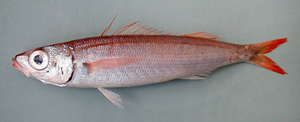Curled picarel facts for kids
Quick facts for kids Curled picarel |
|
|---|---|
 |
|
| Conservation status | |
| Scientific classification | |
| Synonyms | |
|
The curled picarel (Centracanthus cirrus) is a type of ray-finned fish that lives in the ocean. It belongs to the Sparidae family, which includes seabreams and porgies. You can find this fish in the warmer parts of the Eastern Atlantic Ocean, the Mediterranean Sea, and the Black Sea. It's the only living species in its group, or genus, called Centracanthus. This fish is caught by fishers, but it's not a major commercial catch.
About Its Name
The curled picarel, Centracanthus cirrus, was first officially described in 1810. A French scientist named Constantine Samuel Rafinesque gave it its name. He found it near Sicily. This fish is special because it's the only living species in its group, or genus, called Centracanthus. Rafinesque also created this genus when he described the fish.
The specific name cirrus comes from a local name for this fish in Sicily, which was cirrú.
What It Looks Like
The curled picarel has a body that is longer than it is deep. Its mouth can stick out quite a bit. The fish has a wide dip in the middle of its top fin, called the dorsal fin. This fin has 13 stiff spines and 9 or 10 soft rays. The fin on its underside, the anal fin, has 3 spines and 9 or 10 soft rays.
Its side fins, called pectoral fins, are longer than its belly fins, known as pelvic fins. The upper part of its body is reddish, and its underside is whitish. The curled picarel can grow up to 34 centimeters (about 13 inches) long. However, it's more common to see them around 12 centimeters (about 5 inches) in length.
Where It Lives
You can find the curled picarel in the temperate western Atlantic Ocean. Its range goes north to Portugal and south to the Canary Islands. It also lives in the Mediterranean Sea and the Black Sea. There have been reports of it near Cape Verde and Mauritania too.
This fish prefers coastal areas. It likes to live over rocky or gravelly seabeds. It's usually found at depths down to 200 meters (about 650 feet). However, it has been seen much deeper, even at 464 meters (about 1,500 feet) in the Ionian Sea. The deepest it has ever been found is 1,000 meters (about 3,300 feet) in the Sea of Marmara.
Its Life and Habits
The curled picarel is a schooling fish. This means they swim together in large groups. In spring and summer, these schools move closer to the coast to spawn, which is when they lay their eggs. This fish mostly eats tiny sea creatures called zooplankton and small fishes.
How It's Fished
The curled picarel is caught by fishers, but it's not one of the most important commercial fish. It can be found in moderate numbers in some areas. Fishers use nets like trammel nets and bottom trawls to catch them. The fish caught are often sold fresh or preserved by drying and salting.
However, the meat of the curled picarel isn't considered very tasty by everyone. So, much of the catch is turned into fishmeal and oil. In 2020, for World Food Day, the World Wide Fund for Nature (WWF) worked with a fishing harbor in Italy called Porto Cesareo. They held a tasting event where five dishes made with curled picarel were offered. This event was a big success! Now, a local food business buys these fish to use in some of its products.


